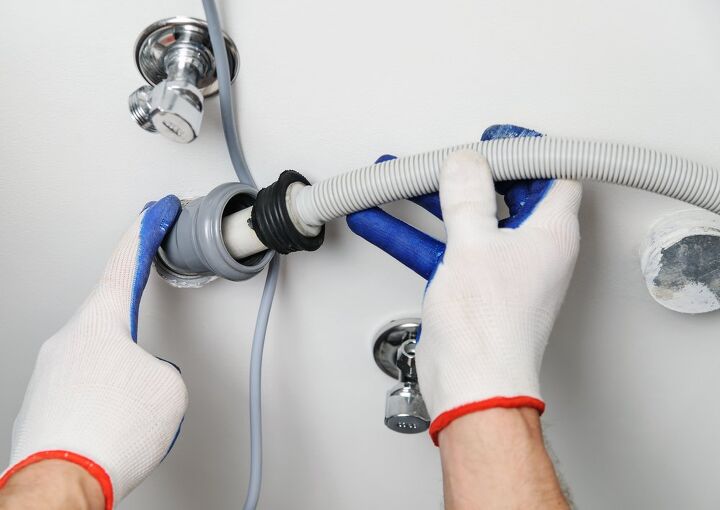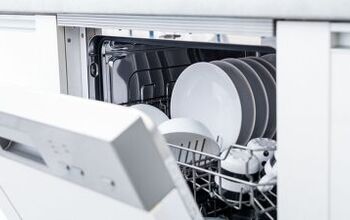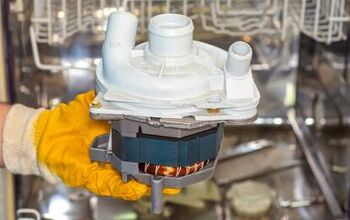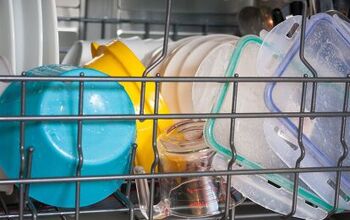How Long Can A Dishwasher Drain Hose Be? (Find Out Now!)

If you’re looking to install your dishwasher a considerable distance away from the kitchen sink, then you’re probably wondering how long the dishwasher drain hose can be. Such is the question answered in this article, and much more important information on dishwasher drain hoses will be provided as well.
A dishwasher’s drain hose can be extended to about 10 to 12 feet, but one must keep in mind the limitations here. This is because the longer a hose is, the more power it’ll need to pump water up through it. One must also consider the high loop, as it has to be at least 20 feet off the ground.
Do You Need Appliance Installation or Replacement?
Get free, zero-commitment quotes from pro contractors near you.

Understanding Dishwasher Drain Hose Length
Most dishwasher drain hoses are 6 1/2 feet long, and nearly all hoses allow for extension up to about 10 to 12 feet. For example, a hose that is heat- and detergent-resistant will have a 7/8 inch inside diameter, and this can be connected to a hose that has a 3/4 inch inside diameter copper tube.
There should also be as few bends as possible, as too many bends will make the hose long, and by extension increase the load for the waste pump the dishwasher utilizes. Running as short as possible is also advised.
A dishwasher hose must have a high loop that’s at least 20 inches above the floor, as this way wastewater will not enter the appliance and clog its drain. Also, many local codes require that a dishwasher hose be connected to a sink on the sink side of the trap, and this is usually accomplished with a branch tailpiece.
Codes in some places also require the use of air-gap technology, and if your dishwasher hose is utilizing one of these, the hose will need to be connected to this first, and then it can be attached to the branch tailpiece or to the garbage disposal directly.
Other Requirements for Dishwasher Drain Hoses
There are times when a drain hose is too long, and in this case it’ll have to be adjusted to fit the limited space. Then, of course, there is the instance when a dishwasher is not near a sink, and it’s here when more hose is needed.
A hose needs to be at a higher level than a dishwasher’s water level too, and it also needs to be above the sink drain. It has to be at a higher spot so that there’s no water back flow into the dishwasher.
One may also need more length when an air gap is required by local code. If you don’t know what kind of hose your system needs when an air gap is required, consult the manufacturer’s manual or ask them directly.
Connecting to the Wrong Side of the Trap
One should also avoid connecting a dishwasher drain to the sewer side of the trap. Water will sit in the bottom of the P-trap, and when this happens sewer gasses are not able to come into a home.
A dishwasher drain has to be connected to the P-trap first, and not after, because if it is not done in this way, there’s a chance that gasses could come back into the dishwasher from the sewer. This is quite a disturbing situation, and that is why proper installation is important.
Extending a Dishwasher Drain: What Needs to Be Done
Lengthening a dishwasher’s drain hose will be required if your dishwasher is far away from the kitchen sink. This much has been established so far. But at this point, you’re probably wondering how a dishwasher drain hose can be extended.
This is a possible DIY task, but in most instances, individuals get professionals to handle this work for them. If you’re interested in learning how you can lengthen a dishwasher drain hose on your own, read through this step-by-step guide.
Step One: Measuring the Drain Pipe
Step one is measuring the outer diameter of the drain pipe. Start at one of the outside edges and go to the opposite outside edge. The measurement here will determine how long your extension has to be.
Next, go to the store and purchase the appropriate fitting. Don’t forget to get a flexible drain covering as well, as this is quite useful when it fits snugly over the drain pipe. These are available at local hardware stores, plumbing stores, and online.
Step Two: Make Sure the Power Is Off
Keep in mind that since you’re working with the dishwasher, an electrical appliance, you should turn it off before doing anything with the drain pipe. An electrical shock is no small matter, and you should protect yourself from these when working with a system.
Just unplug the dishwasher and then proceed with the drain pipe extension. You could also go a step further and cut off power to the dishwasher’s main circuit. Once the breaker is switched, you’ll know there’s no way the system can shock you.
Step Three: Locating and Loosening the Hose
Once the power is off, and you know you can work safely, then you should locate the drain hose, specifically where it’s attached to the sink. If it’s not attached to the sink, it may be attached to the garbage disposal. It also could be connected to a tailpiece that’s right under the drain.
Dishwasher connections are often different, so check to see what your specific installation requires. Once you know where the hose is, then you’ll just need to loosen it by undoing the clamp that’s holding it in place. You’ll need a screwdriver to make this happen, and you’ll also need to keep track of the appropriate screws; these will be needed later when you fasten the clamp again.
Step Four: Attaching the Coupling
Now it’s time to get the drain coupling, as this is what’s needed to attach the existing drain to the new piece. Attach the coupling to a piece of drain pipe on one end, and you should see that there’s a notch on the inside which determines how the pipe is to be positioned.
After tightening the hose clamp, you should insert your extension into the other side of the coupling. You’ll want to make sure that the seal is waterproof and leak-proof too. Once the extension meets the end of the coupling, you’ll know you have found the halfway point. All that’s left now is to tighten up the hose clamp.
Step Five: Reconnecting and Finishing Up
Once you know that the connection is secure, you can reconnect the hose. Connect it back to where you found it under the sink, and then reapply the covering. Before you run the system, make sure everything is secured properly one last time. Finally, you can turn the power back on and start utilizing your dishwasher with the extended hose drain.
Do You Need Appliance Installation or Replacement?
Get free, zero-commitment quotes from pro contractors near you.

What You Should Know About Air-Gap Filters
An air gap is a safety device that’s mounted to a sink or countertop, and your dishwasher’s drain hose will pass through this. It prevents dirty water from getting back into the dishwasher, where clean dishes may be.
Not all dishwashers utilize this device, but those that do will require an extended drain pipe. This is important to know when considering the high loop and back flow prevention.

Matt loves everything DIY. He has been learning and practicing different trades since he was a kid, and he's often the first one called when a friend or family member needs a helping hand at home. Matt loves to work with wood and stone, and landscaping is by far his most favorite pastime.
More by Matthew Mountain



























